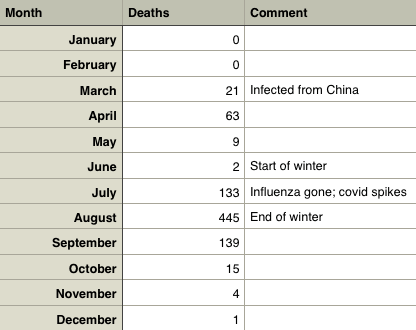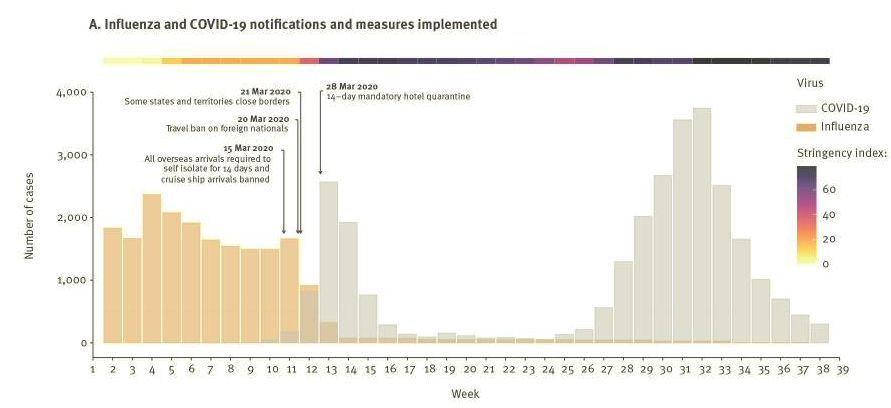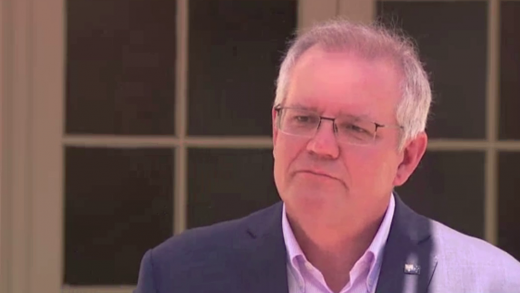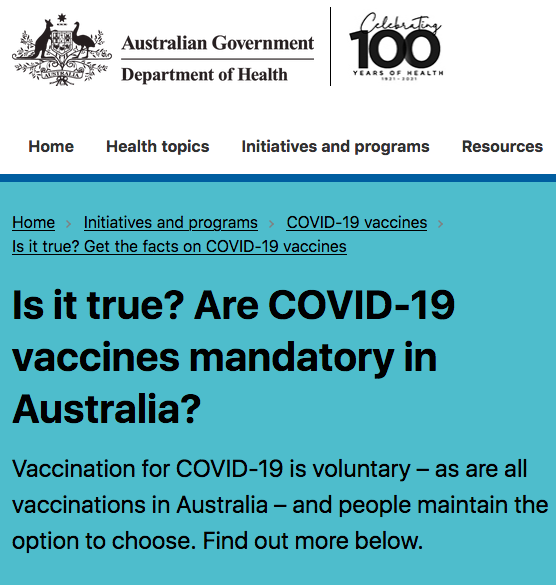Australia hasn’t recorded a single influenza death since July of 2020, according to the Australian Bureau of Statistics (ABS), which is around the time when covid deaths spiked as we headed into winter.
2020 COVID DEATHS

In total, there were 832 covid deaths recorded in Australia in 2020, according to ABS’ provisional data (909 deaths according to Covid Live).
And influenza deaths? There were only about 40 influenza deaths recorded for the whole year.
Pneumonia, which is an inflammation disease of the lungs (often associated with influenza, but can be caused by other pathogens) accounted for an additional 2,000 deaths (respiratory diseases accounted for around 12,000 deaths overall).
Were there excess deaths? Not really — only around 200 excess deaths when compared with the average of the past five years — nothing that can be attributed to covid or any respiratory illness.

Australia had being going through a bit of an influenza epidemic over the previous few years.
2019 was considered one of the worst flu seasons on record (though I feel like they say that every year) with over 4,100 deaths attributed to influenza and pneumonia.
In 2018, there were more than 3,100 deaths associated with influenza and pneumonia.
In 2017, more than 1,250 deaths were recorded under influenza as the cause of death, and when grouped together, influenza and pneumonia accounted for 4,269 deaths.

An individual dying from influenza in 2017 was most likely to be female, aged over 75 years, have multiple co-morbidities and living in the eastern states of Australia.
Australian Bureau of Statistics, 2018
And how’s 2021 going? Well, no influenza, obviously. Our first covid death occurred in mid-April, but numbers didn’t spike until winter kicked in again — about 50 covid deaths so far this year and winter is almost done.
So far this year, there have been over 3,800 deaths from respiratory illnesses; zero attributed solely to influenza, 50 attributed to covid, and only a few hundred deaths attributed to pneumonia.
The big science brains imply that the new covid disease, and subsequent quarantines, have given influenza the old one-two punch and essentially knocked it out of circulation — try as they might, they can’t find it.
The coronavirus disease pandemic was declared in March 2020, as the southern hemisphere’s winter approached. Australia expected co-circulation of severe acute respiratory syndrome coronavirus 2, influenza and other seasonal respiratory viruses. However, influenza notifications were 7,029 (March–September) compared with an average 149,832 for the same period in 2015–2019, despite substantial testing. Restrictions on movement within and into Australia may have temporarily eliminated influenza. Other respiratory pathogens also showed remarkably changed activity in 2020.
Eurosurveillance 2020
However, during 2020, only the state of Victoria imposed heavy restrictions and the remainder of the country remained fairly open for a good 18 months. And it was really only Victoria that suffered a spike in covid cases, which coincided with the advent of winter, like a typical seasonal virus; it’s just that, influenza was conspicuously absent, even though other respiratory infections have remained (albeit numbers are down a bit).
Personally, I can trace virtually all my acquired respiratory infections of the last few years (and I have had many) to having pre-school and kindergarten-age children. Parents frequently send their snotty kids to school because they can’t care for them, due to work commitments, and I have gone through years in recent memory where I was contracting an illness every month because of this — the kids constantly bringing something home. Even during this current lockdown, having sent one kid to pre-school a couple of times, I have managed to contract something.
Looking at the data of the last few years, it is clear that pneumonia has typically been associated with influenza, and ABS lumps them together as a category. So distinguishing them as separate causes has not been an apparent priority. Further, doctors certifying deaths have some degree of discretion as to the cause of death, and may judge it based on patient signs and symptoms, rather than a specific viral detection.
Quarantine and restrictions appear to have had some impact, as all respiratory infections have taken a bit of a dive, but with regards to influenza and covid, this just looks like a case of the old switcheroo — out with influenza and in with covid.

Influenza is notifiable in Australia and notifications averaged around 2,000 cases per week from January to March 2020, with a precipitous drop between mid-March (week 11) and mid-April (week 14), when travel and work restrictions were introduced. Concurrently, COVID-19 notifications began to increase, peaking in April 2020 at levels comparable to the inter-seasonal influenza activity seen from January to February.
A second COVID-19 epidemic was experienced in the state of Victoria only, in July 2020, leading to the re-implementation of strict control measures and accounting for the vast majority of cases notified (94%) from July to September. However, the subsequent relaxation of restrictions across most of the country has not been accompanied by increases in influenza notifications during the normal influenza season
Eurosurveillance, 2020
In 2020, my wife had a pretty serious cough that lasted for a couple months. Initially, she went to the doctor and was tested for covid. A week later the results came back negative. She went back to the doctor and said her cough hadn’t subsided, but the covid test was negative. They wanted to conduct another covid test; the idea that it could have been anything other than covid at that time, just wasn’t on the menu — finding covid in every patient was the priority. She never got a diagnosis for what looked like the worst cough she had ever had.
It may very well be that covid literally is just the flu, if you want my tinfoil take on it — it’s hard to believe it just disappeared forever. Either that or they are no longer using tests that can detect influenza, because they want covid to look worse in comparison, in order to stoke more fear and to quash the “just a flu” meme.
The reality is, people never took flu seriously, even during periods of so-called “epidemics” — flu had been around too long and people were accustomed to it — and so they didn’t take to the flu vaccine that they tried to push every year.
Covid is different now: it’s the new kid on the block, everyone is afraid of it, everyone is taking it seriously, and everyone will get their one, two, and now three “vaccines,” just as they had intended with influenza. Out with the old, in with the new.
Stay terrified.
REFERENCE LINKS
- https://covidlive.com.au/
- https://www.ncbi.nlm.nih.gov/pmc/articles/PMC7693168/
- https://www.sonichealthplus.com.au/health-hub/flu/2019-flu-season-2nd-worst-on-record
- https://www.abc.net.au/news/2020-02-11/early-outbreaks-to-blame-for-worst-flu-season-on-record/11949320
- https://www.abs.gov.au/ausstats/abs@.nsf/Lookup/by%20Subject/3303.0~2017~Main%20Features~Deaths%20due%20to%20influenza~5
- https://www.abs.gov.au/statistics/health/causes-death/causes-death-australia/2018
- https://www.abs.gov.au/statistics/health/causes-death/causes-death-australia/latest-release
- https://www.abs.gov.au/articles/measuring-excess-mortality-australia-during-covid-19-pandemic
- https://www.abs.gov.au/statistics/health/causes-death/provisional-mortality-statistics/jan-dec-2020
- https://www.abs.gov.au/statistics/health/causes-death/provisional-mortality-statistics/jan-2020-apr-2021
- https://www1.health.gov.au/internet/main/publishing.nsf/Content/ozflu-surveil-season-summary-2020.htm
- https://www.cdc.gov/nchs/data/nvss/coronavirus/Alert-2-New-ICD-code-introduced-for-COVID-19-deaths.pdf



